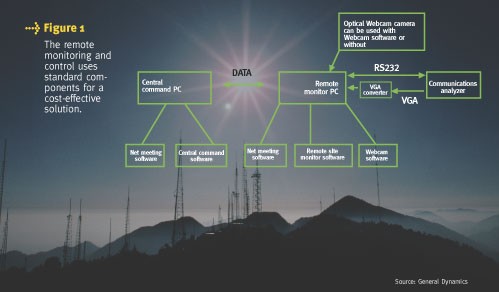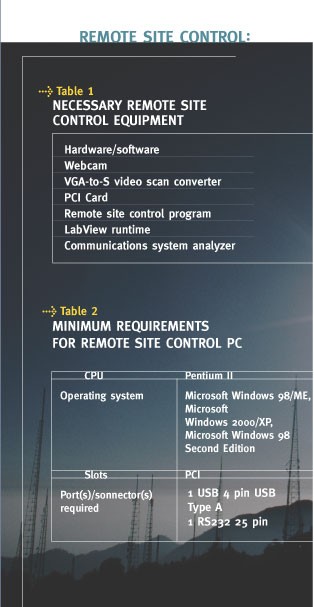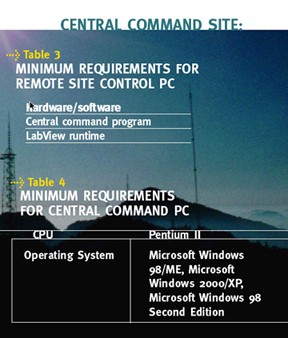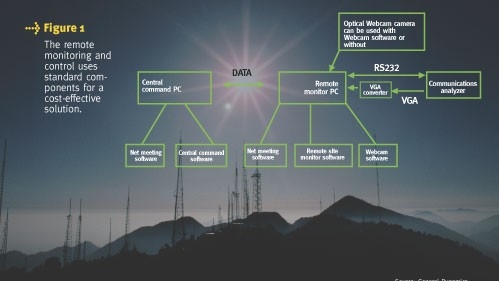Mountain climbing made easy
In large distributed communications systems, it often is necessary to locate base station equipment in remote locations, such as on mountaintops, to take advantage of their geographic and topographic benefits. These modern communications systems also require frequent monitoring and adjustment for optimum performance. Together, these two essential requirements present a significant challenge to those responsible for maintaining and servicing such sites.
Traditionally, when a remote site requires maintenance, the service technician must bring all equipment necessary to handle any possible problem or else risk having to make multiple trips to the remote site. A remote monitoring and control application provides the technician with an indication of how much maintenance is needed prior to visiting the site. This permits the technician to select and transport only the equipment necessary for repairs.
Using readily available off-the-shelf software and consumer electronics, maintaining optimal performance of remote communications sites is easy and cost-effective. The remote operation of a communications analyzer by a technician at a central command site can identify specific maintenance needs and eliminate unnecessary trips to the remote location.

In addition, service personnel can maintain multiple remote base stations from a single central location. The ability to simultaneously monitor multiple remote communications equipment installations can reduce costs by minimizing the number of personnel and equipment needed to monitor and maintain each base station.
Any test and measurement situation can be categorized by two components: the operations to be monitored and the equipment needed to perform the monitoring. Performing the monitoring at a remote location adds an additional component, a communication link to relay information between the observer and the remote location. The following discusses these basic components.
Operations: Remote site monitoring may include measurements such as noise interference evaluation, spurious signal content, signal quality, as well as radio traffic. Additionally, more complicated measurements such as SINAD, bit error rate, transmit power and receiver sensitivity measurements may be required.
Equipment: The remote monitoring and control application requires that a remote-controllable communications system analyzer be installed in the base station, along with a device used to provide the communications link between the user and the analyzer.
Communications link: A standard communications link (e.g. analog, ISDN, DSL, cable, wireless or Ethernet) between the remote site and the control site is required to perform remote monitoring and to transmit the data. Because bandwidth is a precious and expensive commodity, the data provided by a remote monitoring application needs to be scalable to minimize usage of the available bandwidth and eliminate unnecessary demands on the network.

When used with a stand-alone PC, a communications system analyzer can monitor all performance aspects of the base station. Such devices provide particularly stable operation, offer the ability to recover from unexpected power interruptions, are able to withstand temperatures between 0 and 50 degrees Celsius (122 degrees Fahrenheit), and have demonstrated an outstanding mean time between failure under field conditions, with an average of 30,000 hours of failure-free operating time.
Communications system analyzers also can operate from different power sources — 110 and 220 VAC and 11 to 16 VDC — providing good flexibility in the field, and offer receive sensitivity of 2 microvolts for 10 dB SINAD (better than -100 dbm). In addition, the analyzers are equipped with an external reference oscillator input, which allows synchronization with the existing signal in the base station.
All of the analyzer’s functionality is provided remotely, including the ability to monitor audio output from the analyzer as well as transmit from the analyzer using audio sent via the network connection from the user’s office PC. The remote site PC and the central command site PC both use a standard Microsoft Windows operating system. This enables the use of existing equipment that is easy to maintain. Because the burden on the remote site computer is minimal, a wide variety of PCs can be used, provided they follow certain specifications (see Tables 2 and 4).

Remote monitoring consists of three main components. First, the analyzer display is distributed using a commercial Webcam software application located on the remote site PC. Second, key information is efficiently exchanged between the sites using a data acquisition and analysis software program such as LabView, developed by Austin, Texas-based National Instruments. The third component sends two-way audio signals over the network between the remote site and central command site.
The video output from the analyzer is converted using a standard video scan converter to create an S-video signal that is then captured using a standard PC video-capture board. The Webcam software provides adjustable frame rates and compression, allowing the user to vary the amount of bandwidth required. When a shared network is used as the data link, the analyzer display is available to any Internet browser on the network, making it easy for the analyzer display to be seen by multiple users simultaneously.
The central command application exchanges information over the network with the remote site control application using standard TCP/IP protocol. The remote site control application then sends the information to the analyzer via an RS232 communications device. Very simple messages are passed, resulting in faster communications and minimal use of bandwidth.
Both the central command and remote site control software applications are offered as stand-alone LabView applications or the video inputs may be obtained upon request. The ability to review the video inputs provides several additional benefits, such as enabling technicians to configure specifications as needed.
The transmission of audio over an IP network can be accomplished through the use of NetMeeting, a standard Windows-based software platform developed by Microsoft. The software must be installed on both the remote site and central command PCs.
NetMeeting enables the monitoring of demodulated audio from the systems analyzer located at the remote location from the central command computer. This unique ability enables technicians to “listen in” on an RF channel at the remote site. Conversely, the systems analyzer can be configured to transmit an RF carrier, modulated with audio sent from the central command site computer. In this manner, both transmit and receive paths can be remotely verified with actual voice signals.
In summary, a remote system monitoring approach provides numerous benefits to the end user. It makes troubleshooting and maintaining optimal performance of the user’s communications systems easy and cost effective by using readily available off-the-shelf software and consumer electronics along with the remote site control and central command site applications available at no charge. At a minimum, technicians would be able to identify necessary adjustments and winnow system failures to identify specific maintenance needs. Unnecessary trips to the remote location are eliminated.
But there are additional benefits, including access control and link security. For example, the system could be configured to allow broad access to viewing the analyzer screen, but allow only users to take control of the setup. Remote training also is possible. A central expert using a remote monitoring system could help less experienced operators set up tests and interpret results. In addition, the remote computer can be configured to record the video of the analyzer display for later download and playback.
Speaking of the computers, the PCs used in such systems can easily be upgraded to accommodate future needs. Since the PC uses standard Microsoft Windows operating system, setup is simple and familiar, and support is widely available. Another benefit is that the system is fully recoverable from unexpected power loss. For example, data could be automatically collected and stored when sensitivity measurements reach pre-set limits, and a date-and-time-stamped screen shot of the analyzer could be saved to document the event. The collected data could then be transferred to the central location for further analysis and storage.
Katrina Scally is a software engineer for the communications test equipment team in the information assurance division of General Dynamics C4 Systems. She is responsible for the development of software enhancements to the General Dynamics R2600 family of communication system analyzers.

















